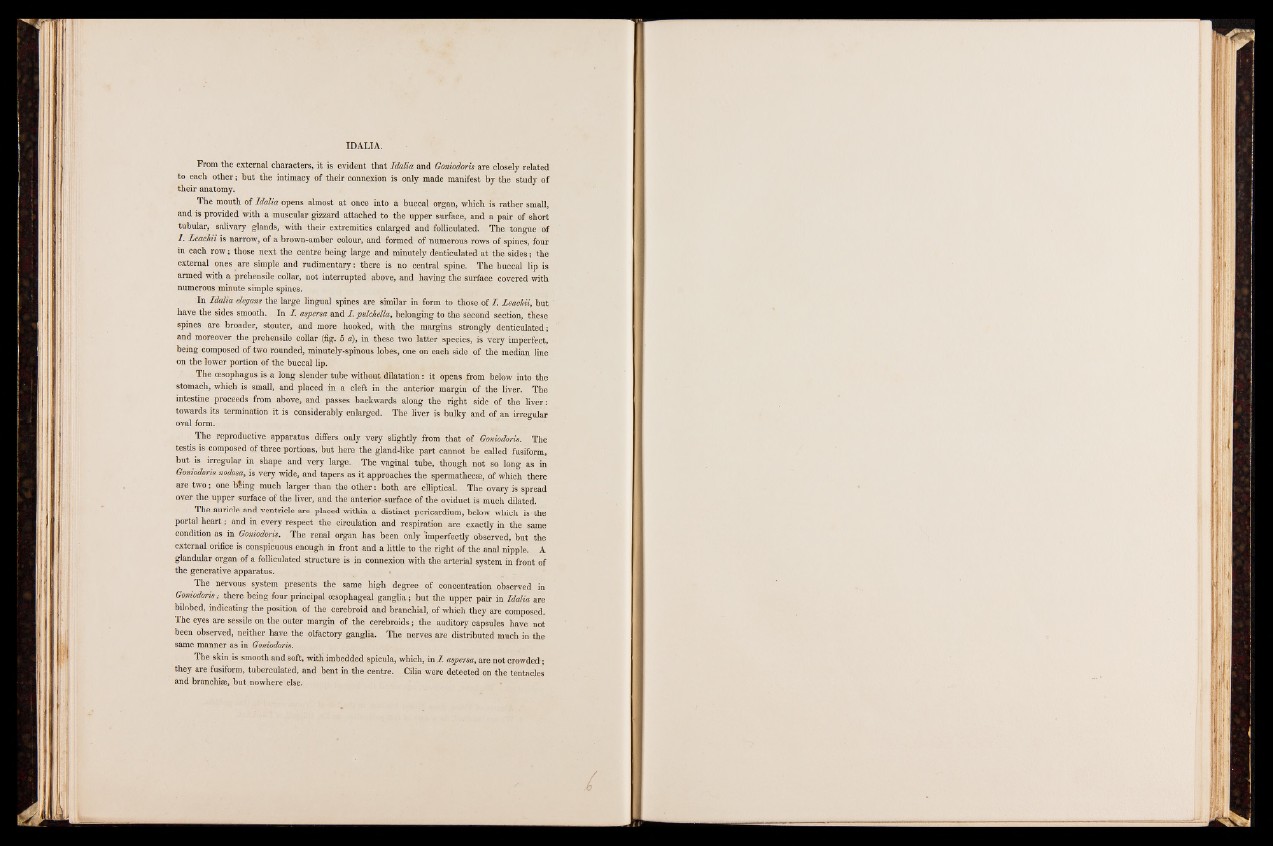
ID ALIA.
From the external characters, it is evident that Idalia and Goniodoris are closely related
to each other; but the intimacy of their connexion is only made manifest by the study of
their anatomy.
The mouth of Idalia opens almost at once into a buccal organ, which is rather small,
and is provided with a muscular gizzard attached to the upper surface, and a pair of short
tubular, salivary glands, with their extremities enlarged and folliculated. The tongue of
/ . Leachii is narrow, of a brown-amber colour, and formed of numerous rows of spines, four
in each row; those next the centre being large and minutely denticulated at the sides; the
external ones are simple and rudimentary: there is no central spine. The buccal lip is
armed with a prehensile collar, not interrupted above, and having the surface covered with
numerous minute simple spines.
In Idalia elegans the large lingual spines are similar in form to those of I. Leachii, but
have the sides smooth. In I. aspersa and I. pidchella, belonging to the second section, these
spines are broader, stouter, and more hooked, with the margins strongly denticulated;
and moreover the prehensile collar (fig. 5 a), in these two latter species, is very imperfect,
being composed of two rounded, minutely-spinous lobes, one on each side of the median line
on the lower portion of the buccal lip.
The oesophagus is a long slender tube without dilatation: it opens from below into the
stomach, which is small, and placed in a cleft in the anterior margin of the liver. The
intestine proceeds from above, and passes backwards along the right side of the liver:
towards its termination it is considerably enlarged. The liver is bulky and of an irregular
oval form.
The reproductive apparatus differs only very slightly from that of Goniodoris. The
testis is composed of three portions, but here the gland-like part cannot he called fusiform,
hut is irregular in shape and very large. The vaginal tube, though not so long as in
Goniodoris nodosa, is very wide, and tapers as it approaches the spermathecse, of which there
are two; one bling much larger than the other: both are elliptical. The ovary is spread
over the upper surface of the liver, and the anterior-surface of the oviduct is much dilated.
The auricle and ventricle are placed within a distinct pericardium, below which is the
portal heart; and in every respect the circulation and respiration are exactly in the same
condition as in Goniodoris. The renal organ has been only imperfectly observed, but the
external orifice is conspicuous enough in front and a little to the right of the anal nipple. A
glandular organ of a folliculated structure is in connexion with the arterial system in front of
the generative apparatus.
The nervous system presents the same high degree of concentration observed in
Goniodoris; there being four principal oesophageal ganglia ; but the upper pair in Idalia are
bilobed, indicating the position of the cerebroid and branchial, of which they are composed.
The eyes are sessile on the outer margin of the cerebroids; the auditory capsules have not
been observed, neither have the olfactory ganglia. The nerves are distributed much in the
same manner as in Goniodoris.
The skin is smooth and soft, with imbedded spicula, which, in I. aspersa, are not crowded;
they are fusiform, tuberculated, and bent in the centre. Cilia were detected on the tentacles
and branchiae, but nowhere else.